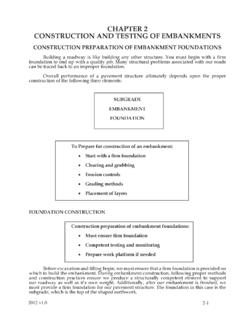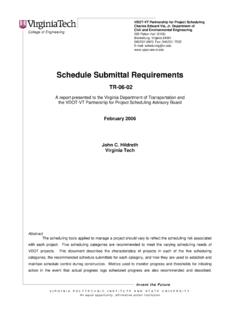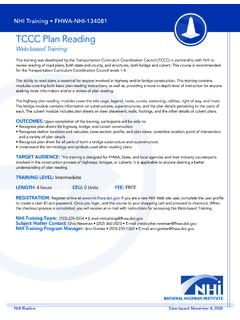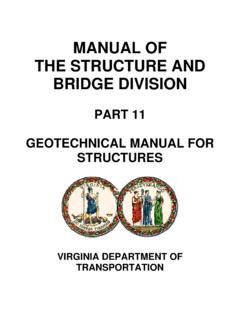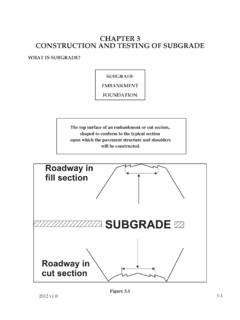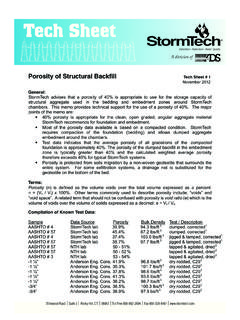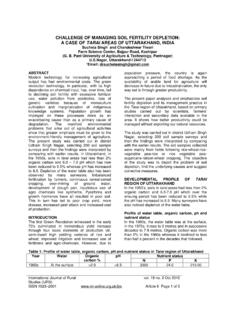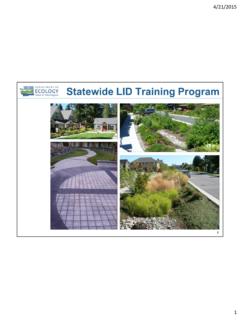Transcription of CHAPTER 7 CORRECTING DENSITY TESTS FOR …
1 7-12012 golden rule of compaction testing is: The proctor used to calculate percent DENSITY must match the soil being tested. This fact is restated here because it is the single factor why plus 4 corrections are states when soil materials contain 10% or more material retained on the No. 4 sieve (3 or more dime size stones), it is necessary to correct the proctor results which are calculated on the minus 4 portion of the material. Basically, this is why: Rocks are heavier than soil. This sounds pretty simple, but this simple fact actually sets up a fairly complex relationship when +4 material is present in a is worth noting here the difference between the presence of +4 material and a rock fi ll.
2 Generally, nuclear DENSITY can be performed on compacted material with up to about 35% +4 material, as long as there are minimum large rocks present (ie., > 8 inches).When +4 material is encountered with the nuclear gauge, a number of trial test locations (4 to 5) may be necessary in order to fi nd a suitable test rocks are heavier than soil, the more present in a soil the higher the maximum DENSITY . To calculate the corrected maximum DENSITY three fi gures are needed: the percentage of +4 material present; the materials specifi c gravity, and the maximum DENSITY of the minus 4 very interesting thing happens with regard to moisture when +4 material is present in a soil.
3 Think about this a moment: If we could separate the +4 from the minus 4 material, we would basically have a soil and some open graded aggregate. When working with aggregates we use the term absorption. This term is kin to optimum moisture because it represents Saturated Surface Dry (SSD) conditions. At SSD, aggregates neither add nor take water from whatever they re mixed with. Optimum moisture for +4 soil materials is generally between 1 & 3 percent. Compare that to typical values for optimum moisture of soils which run from as low as 6% to over 30%. The optimum moisture for the total soil is a weighted average of the optimums for the two materials we ve separated. Knowing the typical values for these optimums, we can understand why the more +4 material present, the lower the optimum these corrected values for maximum DENSITY and optimum moisture are applied to fi eld densities the relationships discussed here will be readily apparent as well as 7 CORRECTING DENSITY TESTS FOR MATERIAL RETAINED ON THE NO.
4 4 SIEVE 7-22012 is included for your convenience, it is for instructional purposes only. For use outside this class, obtain the current VTM from the State Materials Test MethodForLaboratory Determination of Theoretical Maximum DensityOptimum Moisture Content of Soils, Granular Subbase, andBase MaterialsDesignation: VTM-1 AASHTO T 99 Method A shall be followed, except as modifi ed below:12. Moisture- DENSITY RelationshipNote 12a. If there is 10% or greater material retained on the No. 4 sieve, use the following corrective procedure for determining the theoretical maximum dry DENSITY and optimum moisture content. Add: Material Containing Plus No.
5 4 Sieve Particles AASHTO T 99 Method A procedure is applicable to soil that contains little or no material retained on the No. 4 sieve. Since the maximum DENSITY curve determined in the laboratory is obtained by utilizing only that material passing the No. 4 sieve, any appreciable amount of larger material contained in the embankment, which is being checked for compaction , will increase the apparent DENSITY , due to the higher specifi c gravity of the stone as compared to the bulk gravity of the compacted dry soil. At the same time, the optimum moisture content will be less, because some of the material passing the No. 4 sieve is replaced with coarser material (the void space is reduced and the total surface area is decreased).
6 (1) The theoretical maximum DENSITY , D of mixtures containing coarse aggregate larger than a No. 4 sieve will be determined by the formula: cffccfDPDPDDD+ = Where:Df = Maximum dry laboratory DENSITY of minus No. 4 material (by AASHTO Designation: T 99), in lb/ft3Dc= Maximum DENSITY of Plus No. 4 material ( lb/ft3 x bulk specifi c gravity by AASHTO Designation: T85 or as estimated by the Engineer), in lb/ft3Pc= Percent plus No. 4 material, expressed as a decimal, andPf= Percent minus No. 4 material, expressed as a decimal or by nomograph (Figure 1) 7-32012 (2) The optimum moisture for the total soil will be determined by the formula: ()WPWPW tccff=+100 Where:Wt = Optimum moisture content for total soil, Wc = Optimum moisture content (absorption), expressed as a decimal, for material retained on No.
7 4 sieve (estimated between 1% and 3%),Wf = Optimum moisture content, expressed as a decimal, for material passing No. 4 = Percent, expressed as a decimal, of material retained on a No. 4 sieve, andPf = Percent, expressed as a decimal, of material passing a No. 4 Notes:1. The DENSITY required in the work will be a variable percentage of the theoretical maximum DENSITY , D , depending upon variations in the percentage of plus No. 4 material in the mixture and upon the position of the material in the work, and will be specifi ed in the applicable section of the specifi The District Materials Engineer will inform the Inspector of the results of the compaction TESTS on the minus 4 material and the specifi c gravity of the +4 material.
8 With this information, the Inspector can then prepare a chart showing the DENSITY of the total sample for varying percentages of the +4 material. 7-42012 Rev. 6/00 VIRGINIA DEPARTMENT OF TRANSPORTATIONREPORT OF SAND CONE DENSITY (UNIT MASS OF SOIL)English Metric Report No.: Date: 10-1-00 Route No.: 637 County: PittsylvaniaProject No.: 0637-071-241,C501 FHWA No.: AC-RS-1491(101)Field Test of TestStation ft. (m.)170 + 00 Ref. To Center Line ft. (m.)ElevationOriginal Ground ft. (m.)Finished Grade ft. (m.)Compacted Depth of Lift in. (mm.)Method of compaction (Type of Roller)SheepsfootDENSITY DETERMINATIONA. Unit wt.( lbs/ft3) or Unit mass (kg/m3) of sand (calibrated value) Wt.
9 (mass) sand + wt. (mass) of jar and cone, lb. (kg) Wt. (mass) sand left in jar + wt. (mass) of jar and cone, lb. (kg) Wt. (mass) of sand in cone and base plate,lb.(kg) (calibrated value) Wt. (mass) sand left in jar + wt. (mass) of jar and cone + wt. (mass) of sand in cone and base plate (C + D), lb.( kg) Wt. (mass) of sand in test hole (B - E), lb. (kg) Volume of test hole (F A), ft3 (m3) Wt. (mass) of wet soil from test hole + (wt.) mass of pan, lb. (kg) Wt. (mass) of pan, lb. (kg) Wt. (mass) of wet soil from test hole (H - I), lb. (kg) Unit wt.( lbs/ft3) or Unit mass (kg/m3) of wet soil in fi ll (J G) Unit wt.( lbs/ft3) or Unit mass (kg/m3) of dry soil in fi ll = K { 1 + [ Moisture Content (T) 100 ] } Max.
10 Dry Unit Wt.( lbs/ft3) or Unit mass (kg/m3) from LAB PROCTOR OR ONE POINT PROCTOR (TL-125a) Optimum Moisture Content from LAB PROCTOR OR ONE POINT PROCTOR (TL-125a) Percent of +No. 4 (plus mm) MaterialP. Corrected Maximum Dry Unit wt. ( lbs/ft3) or Unit mass (kg/m3)Q. Corrected Optimum Moisture (%)R. % compaction (L M) 100 or (L P) % Minimum DENSITY (unit mass) required (from specifi cations)95 MOISTURE DETERMINATION (For Field Dried Method)a. Dish and damp soil, lb. (kg) Dish and dried soil, lb. (kg) Wt. (mass) moisture (a - b), Wt. (mass) dish, lb. (kg) Wt. (mass) dry soil (b - d), lb. (kg) Moisture Content (c e) 100 or from Speedy Moisture of +4 MaterialOn compaction TestsAcceptable Moisture Range 20% of Optimum - High DensityFalse Low Moisture 7-52012 (Rev.)
